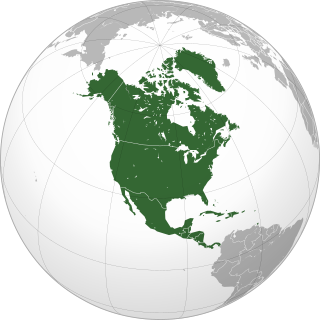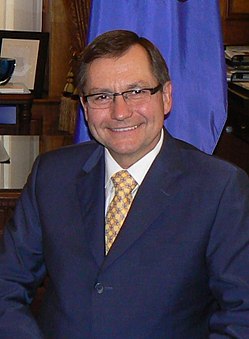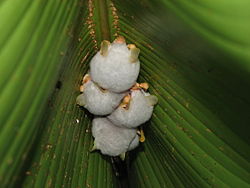Top Qs
Timeline
Chat
Perspective
Portal:North America
Wikipedia portal for content related to North America From Wikipedia, the free encyclopedia
Remove ads
The North America Portal

North America is a continent in the Northern and Western hemispheres. North America is bordered to the north by the Arctic Ocean, to the east by the Atlantic Ocean, to the southeast by South America and the Caribbean Sea, and to the south and west by the Pacific Ocean. The region includes Middle America (comprising the Caribbean, Central America, and Mexico) and Northern America.
North America covers an area of about 24,709,000 square kilometers (9,540,000 square miles), representing approximately 16.5% of Earth's land area and 4.8% of its total surface area. It is the third-largest continent by size after Asia and Africa, and the fourth-largest continent by population after Asia, Africa, and Europe. As of 2021[update], North America's population was estimated as over 592 million people in 23 independent states, or about 7.5% of the world's population. In human geography, the terms "North America" and "North American" refers to Canada, Greenland, Mexico, Saint Pierre and Miquelon, and the United States.
It is unknown with certainty how and when first human populations first reached North America. People were known to live in the Americas at least 20,000 years ago, but various evidence points to possibly earlier dates. The Paleo-Indian period in North America followed the Last Glacial Period, and lasted until about 10,000 years ago when the Archaic period began. The classic stage followed the Archaic period, and lasted from approximately the 6th to 13th centuries. Beginning in 1000 AD, the Norse were the first Europeans to begin exploring and ultimately colonizing areas of North America.
In 1492, the exploratory voyages of Christopher Columbus led to a transatlantic exchange, including migrations of European settlers during the Age of Discovery and the early modern period. Present-day cultural and ethnic patterns reflect interactions between European colonists, indigenous peoples, enslaved Africans, immigrants from Europe, Asia, and descendants of these respective groups. (Full article...)
This is a Featured article, which represents some of the best content on English Wikipedia.
The Texas Revolution (October 2, 1835 – April 21, 1836) was a rebellion of colonists from the United States and Tejanos (Hispanic Texans) against the centralist government of Mexico in the Mexican state of Coahuila y Tejas. Although the uprising was part of a larger one, the Mexican Federalist War, that included other provinces opposed to the regime of President Antonio López de Santa Anna, the Mexican government believed the United States had instigated the Texas insurrection with the goal of annexation. The Mexican Congress passed the Tornel Decree, declaring that any foreigners fighting against Mexican troops "will be deemed pirates and dealt with as such, being citizens of no nation presently at war with the Republic and fighting under no recognized flag". Only the province of Texas succeeded in breaking with Mexico, establishing the Republic of Texas. It was eventually annexed by the United States about a decade later.
The revolution began in October 1835, after a decade of political and cultural clashes between the Mexican government and the increasingly large population of Anglo-American settlers in Texas. The Mexican government had become increasingly centralized and the rights of its citizens had become increasingly curtailed, particularly regarding immigration from the United States. Mexico had officially abolished slavery in Texas in 1829, and the desire of Anglo Texans to maintain the institution of chattel slavery in Texas was also a major cause of secession, although slavery is never mentioned implicitly or explicitly in the Declaration of Independence of Texas. Colonists and Tejanos disagreed on whether the ultimate goal was independence or a return to the Mexican Constitution of 1824. While delegates at the Consultation (provisional government) debated the war's motives, Texians and a flood of volunteers from the United States defeated the small garrisons of Mexican soldiers by mid-December 1835. The Consultation declined to declare independence and installed an interim government, whose infighting led to political paralysis and a dearth of effective governance in Texas. An ill-conceived proposal to invade Matamoros siphoned much-needed volunteers and provisions from the fledgling Texian Army. In March 1836, a second political convention declared independence and appointed leadership for the new Republic of Texas. (Full article...)
This is a Featured picture that the Wikimedia Commons community has chosen as one of the highest quality on the site.

The Bald Eagle is a raptor that is indigenous to North America, and is the national symbol of the United States of America. The species was on the brink of extinction late in the 20th century but has largely recovered and now has a stable population. Its diet is varied, including fish, smaller birds, rodents, and sometimes food scavenged or stolen from campsites and picnics.
This is a Featured article, which represents some of the best content on English Wikipedia.
Edward Michael Stelmach ECA AOE (/ˈstɛlmæk/; born May 11, 1951) is a Canadian politician who served as the 13th premier of Alberta, from 2006 to 2011. The grandson of Ukrainian immigrants, Stelmach was born and raised on a farm near Lamont and fluently speaks the distinctive Canadian dialect of Ukrainian. He spent his entire pre-political adult life as a farmer, except for some time spent studying at the University of Alberta. His first foray into politics was a 1986 municipal election, when he was elected to Lamont County council. A year into his term, he was appointed reeve. He continued in this position until his entry into provincial politics.
In the 1993 provincial election, Stelmach was elected as the Member of the Legislative Assembly (MLA) for Vegreville-Viking (later Fort Saskatchewan-Vegreville). A Progressive Conservative, he served in the cabinets of Ralph Klein—at various times holding the portfolios of Intergovernmental Relations, Transportation, Infrastructure, and Agriculture, Food, and Rural Development—where he developed a reputation as a low-key politician who avoided the limelight. When Klein resigned the party's leadership in 2006, Stelmach was among the first to present his candidature to replace him. After a third-place finish on the first ballot of the leadership race, he won an upset second ballot victory over former provincial treasurer Jim Dinning. (Full article...)
This is a Good article, an article that meets a core set of high editorial standards.
The Honduran white bat (Ectophylla alba), also called the Caribbean white tent-making bat, is a species of bat in the family Phyllostomatidae. It is the only member of the genus Ectophylla. The genus and the species were both scientifically described for the first time in 1892. It has distinctive, entirely white fur, which is only found in six of the roughly 1,300 known species of bat. It constructs "tents" out of understory plant leaves by strategically cutting the leaf ribs with its teeth; it roosts in these tents during the day. It is a specialist frugivore, consuming almost exclusively the fruits of one species of fig. Females can likely become pregnant twice per year, giving birth to one offspring at a time.
It is found in Honduras, Nicaragua, Costa Rica and western Panama at elevations from sea level to 700 m (2,300 ft). Due to habitat loss, it is evaluated as near-threatened by the IUCN. Its bright yellow ears, nose-leaf, and lips are a result of carotenoid deposition; the mechanism of this deposition is being researched as a way to understand and combat macular degeneration in humans. (Full article...)
Did you know...
- ...that in 1869 the Spanish colonial authorities banned Baseball in Cuba because Cubans began to prefer baseball to viewing bullfights, the Spaniards' national sport?
- ...that a circumferentor (pictured) was an important tool to surveyors for mapping the North American frontier?
- ...that the French West Indies refers to the two French overseas departments of Guadeloupe and Martinique, and also includes the Guadeloupean dependencies of French St. Martin, Saint-Barthélemy, Les Saintes, Marie-Galante and La Désirade?
- ... that the Valley of Mexico has been one of the most heavily populated places on the planet for almost two millennia?
- ...that Jacob Piatt Dunn in 1886 wrote the first scholarly history concerning the Indian Wars?
Selected panorama

The San Juan Mountains are a rugged mountain range in the Rocky Mountains in southwestern Colorado. The Rio Grande rises on the east side of the range. The San Juan and Uncompahgre National Forest cover a large portion of the San Juan Mountains.
Topics
Categories
List articles
Related portals
Northern America
Central America
Caribbean
WikiProjects
 North America
North America-
 Canada
Canada -
 Greenland
Greenland -
 Mexico
Mexico -
 Saint Pierre and Miquelon
Saint Pierre and Miquelon -
 United States
United States  Central America
Central America-
 Belize
Belize -
 Costa Rica
Costa Rica -
 El Salvador
El Salvador -
 Guatemala
Guatemala -
 Honduras
Honduras -
 Nicaragua
Nicaragua -
 Panama
Panama  Mesoamerica
Mesoamerica Caribbean
Caribbean-
 Antigua and Barbuda
Antigua and Barbuda -
 Bahamas
Bahamas -
 Barbados
Barbados -
 Bermuda
Bermuda -
 Cuba
Cuba -
 Dominica
Dominica -
 Dominican Republic
Dominican Republic -
 Grenada
Grenada -
 Haiti
Haiti -
 Jamaica
Jamaica -
 Puerto Rico
Puerto Rico -
 Saint Kitts and Nevis
Saint Kitts and Nevis -
 Saint Lucia
Saint Lucia -
 Saint Vincent and the Grenadines
Saint Vincent and the Grenadines -
 Trinidad and Tobago
Trinidad and Tobago
Associated Wikimedia
The following Wikimedia Foundation sister projects provide more on this subject:
-
Commons
Free media repository -
Wikibooks
Free textbooks and manuals -
Wikidata
Free knowledge base -
Wikinews
Free-content news -
Wikiquote
Collection of quotations -
Wikisource
Free-content library -
Wikiversity
Free learning tools -
Wikivoyage
Free travel guide -
Wiktionary
Dictionary and thesaurus
More portals
Remove ads
Wikiwand - on
Seamless Wikipedia browsing. On steroids.
Remove ads

















